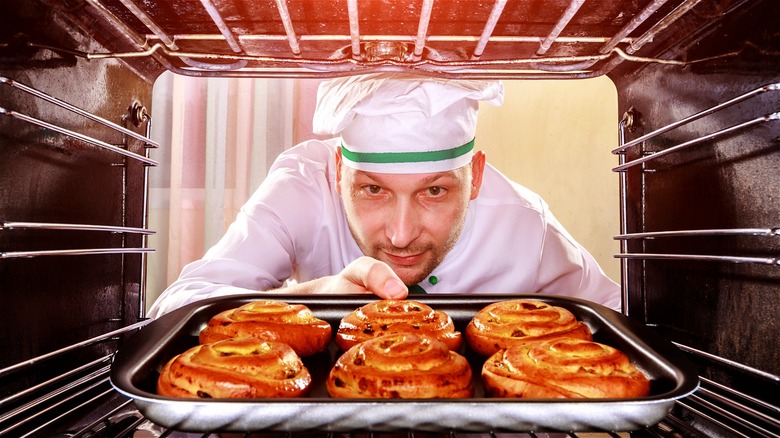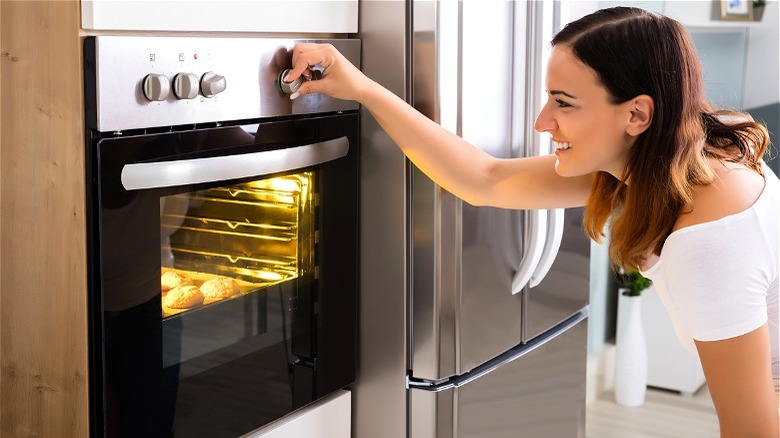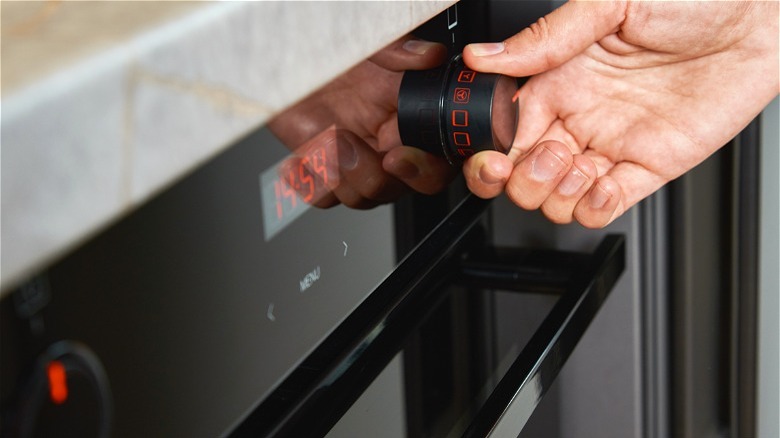Here's Why 350 Degrees Fahrenheit Is Always The Suggested Temperature For Baking
Most avid bakers know how to throw a recipe together loosely and find moderate to successful results. Any baked confection made with enough flour, butter, sugar, eggs, and a small amount of baking powder or soda will come out somewhat tasty. Chances are, if you're throwing a random cookie recipe or even a sheet pan vanilla cake recipe in the oven on a whim, you'll set the baking temperature at 350 degrees Fahrenheit.
There's something about 350 degrees that just feels safe. There must be a glimmer of truth somewhere in the culinary hive mind that recipes won't be scorched or ruined if ingredients are baked long enough at this non-threatening degree. But why does this exact temperature feel reliable to us?
Sure, there was a time in history when our ancestors had to bake their food over homemade pits filled with burning hot coals from well-managed fires. With the passing of years, technology led to advancements in the culinary world. Cast iron stoves became a modern convenience in the 18th century. With the invention of gas and electric stoves in the late 1800s, ovens became more manageable for the everyday home cook. But before the mid-20th century, most ovens operated on a three-temperature scale which ranged from warm to hot. Further advancements in oven-dial technology led to more specificities in recipes, and our love for a reliable median temperature was born.
What's so special about 350 degrees?
Before oven dials became more advanced and still ran on a three-temperature scale, "moderate" was the middle-of-the-road temperature used for most baked goods. It eventually became known as the popular median temperature of 350 degrees. With the development of gas and electric ovens coupled with home cooks' eventual ability to set them in five-degree increments, 350 degrees Fahrenheit became the median temperature of choice for more than one reason.
When we look at the science at play, there are some amazing chemical reactions that occur when ovens heat. For one thing, there's a solid rationale for why every cook needs to understand the Maillard reaction. Right around 285 degrees Fahrenheit, flavor development takes on a new meaning when protein and sugar react, lending a rich, deepened color to your favorite baked goods. Caramelization also takes place around 320 degrees. These two chemical reactions not only change the appearance of food but also develop the complexity of flavors.
The most important takeaway here is that at 350 degrees, a number of valuable chemical reactions take place at a moderate temperature. But what happens if set your oven at 325 degrees Fahrenheit for a recipe that calls for a 350-degree cook time? Will your resulting dish be impacted?
All ovens experience inconsistency in temperature
You probably didn't know that most ovens aren't always calibrated to exact precision. In fact, setting your oven to 350 degrees Fahrenheit allows for plenty of wiggle room. There are spots within your oven that often shift in temperature, and most modern ovens include a gauge that allows a set temperature to drop to a certain extent before the heat kicks on again.
Most ovens fluctuate around 20 degrees in either direction of the set temperature. That's why periodically checking your oven's temperature is absolutely essential. To do this, purchase a cheap oven thermometer, and place the gadget on the middle rack of your oven. Then, set your oven's temperature and check the gauge periodically, while also paying attention to the extra details, such as how long it takes for your oven to preheat.
If your oven runs a bit hot or cold, there's one easy way to fix this yourself. Keep a watchful eye — sometimes, adjusting the set temp will ensure your tasty treats are pulled out of the oven at just the right time. So, if you accidentally bake cookies at 325 degrees instead of 350, you may just need to keep them in the oven a tad longer. 350 degrees Fahrenheit may be the most common temperature, but this number also serves as a reliable baseline for bakers and continues to hold a considerable amount of variability.


